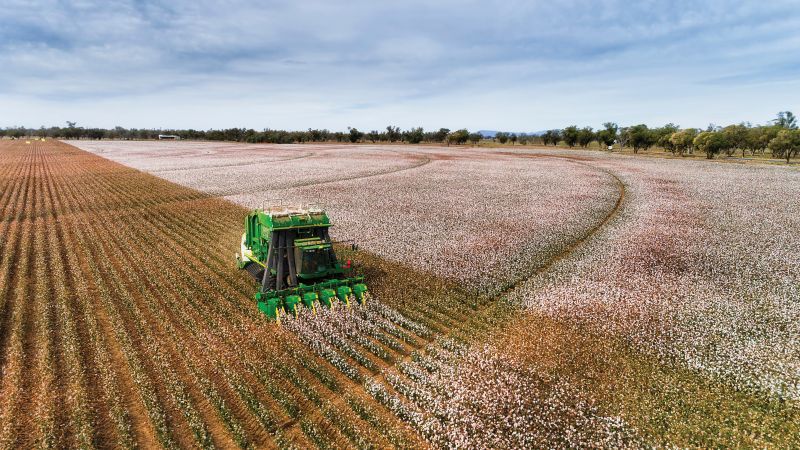‘Perfect Weed’ Wreaks Havoc on U.S. Crop
The Memphis Commercial Appeal
At the seasoned age of 54, Willie Cutler figured he’d never be doing this again — swinging a hoe to cut weeds in a field of waist-high cotton.
But one recent morning, as the sun crept above the treetops and mosquitoes and dragonflies hovered in the sticky air, there he was, with a dozen or so other laborers, chopping cotton just as he’d last done some 40 years ago.
“You’ve got to do something to get some money,” said Cutler, a Hughes native who also drives trucks and farm equipment.
Chopping cotton, a chore and tradition recalling the days of the preindustrial South, is making a comeback this year for reasons that have nothing to do with nostalgia and everything to do with the limits of technology.
All across the Mid-South, hundreds of thousands of acres of cotton and soybean fields have been infested with a rapacious, fast-growing weed that’s become resistant to the main herbicide on which farmers have relied for more than a decade.
A Serious Infestation
Palmer pigweed, often called “careless weed” by field hands, often is surviving and even thriving despite treatments with the chemical glyphosate — most commonly sold under the trade name Roundup.
In Arkansas alone, the weed has invaded some 750,000 acres of crops, including half the 250,000 acres of cotton. In Tennessee, nearly 500,000 acres have some degree of infestation, with the counties bordering the Mississippi River hardest hit.
The infestation is cutting farmers’ cotton yields by up to one-third and in some cases doubling or tripling their weed-control costs.
Reminiscent of the premechanized, preherbicide days when cotton was a labor-intensive operation, growers have resorted to hiring chopping crews. They’re made up of laborers who generally are paid about $7.50 an hour to manually cut the weeds.
“We haven’t chopped cotton in a long time, so it’s kind of a first,” said Lee Wiener, who farms in Crittenden and Mississippi counties.
Beyond the novelty of requiring manual labor, the resistance problem will force growers to make wrenching and costly changes if they want to stay in business in the coming years, agriculture experts say.
Glyphosate is the most widely used herbicide in the U.S., with some 100 million pounds annually applied to crops and lawns.
It’s so prevalent that cotton, soybeans and other plants have been genetically engineered to withstand it, allowing farmers to spray the chemical quickly and easily to kill weeds without worrying about harming crops.
“I think this threatens our way of farming more than anything I’ve seen in the 30-plus years I’ve worked in agriculture,” said Ken Smith, weed scientist with the University of Arkansas’ division of agriculture.
In fact, some officials draw parallels between the pigweed resistance problem and the effects of the boll weevil infestation of cotton fields in the early 20th century.
The Perfect Weed
What makes the weed such a formidable threat is its rapid growth rate — more than an inch per day — and the proliferation that results from a single plant producing 50,000-100,000 seeds.
Rising up to 10 feet tall, with stalks as thick as baseball bats, the plant also can wreck any mechanical cotton-pickers sent into heavily infested fields. Since it outcompetes cotton for water and other resources, infestation easily can cut yields by 300 pounds per acre.
“If you wanted to draw up the perfect weed, this is it,” said Larry Steckel, extension weed specialist with the University of Tennessee Extension Service.
Officials with Monsanto Co., maker of Roundup, acknowledge the resistance problem. They say it resulted from over-reliance on that one product since it became the herbicide of choice in the 1990s. The resistance has intensified as weed strains that survive the spraying reproduce.
“As you continue to use just that one single herbicide, you wind up selecting weeds that are a bit more tolerant. And as you do that year after year, you increase those populations until you have the resistance problem we’ve got,” said Rick Cole, a Monsanto technology development manager specializing on weed resistance.
Monsanto has been advising farmers to add other chemicals, especially pre-emergents and other “residual” herbicides, which form a chemical barrier in the soil, to their weed-fighting regimens.
Monsanto also has begun a test program that pays farmers up to $12 an acre to treat crops with other chemicals, including those made by competitors, Cole said.
Steckel and many growers say if Roundup was overused it was because the chemical was so easy to apply and so widely effective.
“Roundup was a victim of its own success,” Steckel said. “It was the perfect herbicide — it controlled regardless of timing, with no crop injury.”
Steckel said he and other experts were “blindsided” by how quickly the resistance problem began this year.
“It got a pretty good foothold last year in some fields, and this year it blew up into many fields,” Steckel said.
The changes wrought by the resistance problem can be seen in places such as Looney’s Implement Co. in Hughes, which sells tractors, combines and pickers that can cost $300,000 or more.
This year one of the hottest items in the store has been the $25 garden hoe.
“We sell them as quick as we can get them,” said clerk Don Arnold.
The tools are being used by the growing ranks of choppers. Some growers have hired as many as 40 to 60 of the laborers. But even during a recession in which jobs have been scarce, it hasn’t been easy finding enough workers, they say.









